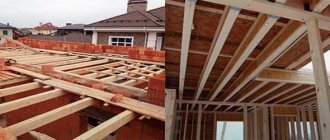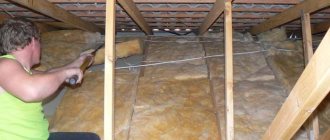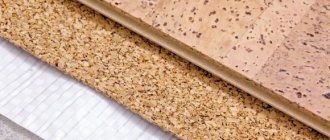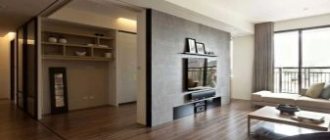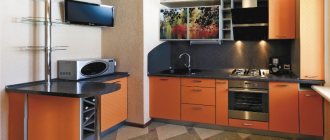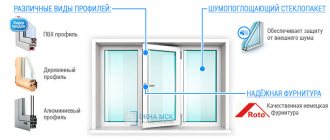Most apartment residents know first-hand about the soundproofing of apartments. And the point here often lies in its low quality, or even in its complete absence. This applies to both new buildings and apartments on the secondary market.
Legally, the soundproofing of an apartment in a panel house is not one of its disadvantages, which eliminates the need for the seller to notify the buyer about this. It turns out that various noises that quietly pass through the walls, floor and ceiling are a personal problem for the residents.
Which house has better sound insulation?
The level of noise and sound absorption largely depends on the design features of the house - and if you have to choose a future home, it is recommended to carefully read the material.
Brick
Leader in comfort for residents. The level of sound insulation in brick houses is maximum - residents are usually not bothered by extraneous sounds and noises coming from both the street and neighbors. If among them there are no avid music lovers and lovers of noisy feasts.
Brick house
Brick-monolithic construction
It has a lower level of sound insulation, which is due to the through vertical structures, which are excellent conductors of sound. Wall partitions in them, as a rule, have good soundproofing, since they are erected from soft materials (foam block, brick, etc.), the main structure of the houses greatly spoils the overall impression.
Brick-monolithic house
Monolithic houses
These are homes for those who like to wake up with the first sounds of a neighbor's hammer drill or the screams of schoolchildren gathering two floors above.
Sound insulation in a monolithic house is completely absent, and the reason for this is not only durable concrete, which perfectly transmits sounds.
Numerous “Stalin”, “Khrushchev”, “Brezhnev” apartments built back in Soviet times and other apartments assembled according to a single design are characterized by a low level of sealing of seams both in the interfloor ceilings and in the panels forming the walls.
Monolithic house
Tips for choosing an apartment
An expensive apartment, offered immediately with interior decoration, looks like a tasty morsel in the eyes of buyers. However, as practice shows, even in modern houses with elite class apartments, the level of sound insulation leaves much to be desired. The point usually lies in maximum time savings on the part of the developer - the use of technologies that allow you to quickly erect a partition often comes at the expense of quality.
For modern apartments, tongue-and-groove walls (hollow gypsum blocks 8 cm thick) have almost become standard. But its purpose is to install a barrier that does not allow neighbors behind it to see each other, and it is difficult to relate the wall thus obtained to a serious partition.
In modern construction, the construction time of buildings is put in first place, often to the detriment of the operational characteristics of objects. Today, when the amount of profit received by the developer depends on the speed of construction, they prefer not to even pay attention to the state of sound insulation, and future residents have to deal with this problem.
Soundproofing the apartment
The quality of sound insulation in inter-apartment partitions directly depends on their thickness. Therefore, it is preferable to opt for houses that have undergone a major renovation - the downward partitions are usually reinforced with asbestos-cement slabs with an air gap, and the sound insulation of apartments in a panel house after a major renovation is close to ideal.
In new buildings, boards and plaster coating are often used to install interior partitions, rather than bricks. This is the reason for the extremely low sound insulation between rooms, which clearly does not add comfort.
The best sound insulation in ancient houses built before the revolution.
Unless, of course, it was worsened by construction companies during major repairs. The walls in them are supported by metal beams, and earth is filled between the wooden panels, which perfectly absorbs any sounds and noises. In such houses, you can hardly hear your neighbors, regardless of the strength of the noise they produce.
“I had nervous breakdowns, insomnia, constant anxiety - will you be able to sleep today or not?”
Anna
editor, PR consultant
– I grew up in a country house and had difficulty getting used to the city anthill after entering a university in Minsk. The first noise - the neighbors on the block in the student dormitory liked to have a party until late at night, but a couple of calls from the duty team more or less calmed them down. Surprisingly, in general, MSLU students normally observed the silence regime, and I felt the most brutality with my neighbors already in the apartment building.
After university, I lived for 15 years in rented apartments in the Zavodskoy district of Minsk. These were all panels with very poor sound insulation. The most common feeling is that you are sitting in a cell in the center of a human settlement and hear other people’s lives from everywhere.
At some point, I realized that I focus my attention very much on some of the everyday sounds, when I can be distracted and generally live with them. But, apparently, this is influenced by the structure of the nervous system, the sensitivity of hearing - plus I grew up in the silence of my home. Therefore, many sounds such as knocking, moving furniture and stomping were annoying at first. Then I muted this particular irritation. But something else remained - swearing, someone else's cacophonous sex, crying. That is, in essence, other people's emotions that are introduced into your life.
We had a neighbor who brought a guy over and he played the guitar through the wall. Then sex. Then she sobbed loudly for half the night, banging her head against the wall a couple of times. And the sound insulation was such that we heard, excuse me, every fart and snoring. They knocked on the wall - to no avail. We tried to talk, called the apartment - to no avail, it never opened.
In the same house, on the third floor, there lived a man who would turn on music at night, put something from a chanson like Mikhail Krug on repeat, and leave. The songs roared throughout the whole house - we couldn’t sleep on the eighth floor. The most amazing thing is that out of the whole house we were the only ones who called the police. But no one answered the door in the apartment, and the police shrugged their shoulders and left. My husband had to open the electrical panel and turn off the lights in this apartment. The most disgusting thing is a complete feeling of powerlessness. The police didn't care. Solve the problem yourself.
I bought earplugs - professional 3M ones helped. I began to fall asleep better with them. Ideally, you need to move - but they still know what hemorrhoids in Minsk are like to change one rented apartment to another. And so as not to get into trouble again.
Thank God, I moved to a country house that my husband and I spent six years building. As soon as it became possible to spend the night in it - on the floor on a mattress, without even wallpaper on the walls - we began to go there on weekends from Friday to Sunday, just to sleep.
I’ll speak for myself: a person who is sensitive to the sounds of someone else’s life may have a nervous breakdown, insomnia, constant anxiety - will you be able to fall asleep today or not?
And the saddest thing in this situation is that in Belarus there are still no sensible standards for soundproofing apartments. And also there is no law that would define exactly how and who to deal with silence breakers.
How to choose a soundproofed apartment
Apartments with the proper level of sound insulation can be identified by several features. For example, at the joints, seams and places where walls meet the ceiling, a special polyethylene-based material should be used (looks like white elastic tubes). It is also recommended to ask the developer or former owner if a floating floor system was used during construction.
Hollow floors made of reinforced concrete have several times better soundproofing characteristics than monolithic ones. The reason for this is both the considerable thickness of the floors and the use of different fillers in their manufacture. Expanded clay, expanded polystyrene or mineral wool are added to modern materials, and shavings or construction waste are added to old structures.
Monolithic floors are perhaps one of the “noisiest” materials - they perfectly transmit all sounds and noises, so sound insulation in a new building made of monolith is simply necessary.
What does an ideal partition consist of?
The best sound insulation in cross-section resembles a multi-layer pie, and ideally all the walls in the house should consist of such a “pie” - both interior and exterior. The main filling of the walls is reinforced concrete, on both sides of which there should be insulation, and then wall stone.
Scheme for soundproofing a wall
For internal partitions, the thickness of the reinforced concrete base should be 60 mm, just as in external walls it should be at least 180 mm.
Also, the quality of double-glazed windows and entrance doors plays a significant role in sound insulation, and in addition to sound insulation characteristics, the thermal insulation of the apartment also depends on this.
If, after purchasing a living space, the happy owner of square meters begins to note with dissatisfaction the presence of extraneous sounds and noises, then it is time to do additional sound insulation.
Might be interesting
Thermal insulation
Distinctive features and variety of ceiling tiles…
Thermal insulation
Features and use of mineral wool
Noise insulation
How to soundproof a balcony roof yourself?
Noise insulation
Soundproofing sewer pipes in an apartment
There are more than enough options for doing this - starting from large-scale work that reliably isolates the owner from any noise, and ending with the localization of a particularly annoying sound source.
Other interesting questions and answers
You can hear your neighbors upstairs. How to reduce audibility?
You can't hear the neighbors at all from the side. The noise and voices are only from above, near the battery. The material of the house is aerated concrete.
Said1
First of all, it is necessary to eliminate all sound-amplifying cavities. They work on the principle of a resonator box. It is necessary to fill all cavities with a solution or at least polyurethane foam. Then it’s better to make acoustic ceilings. These are suspended ceilings with additional elements. When constructing the ceiling frame, vibration isolation must be done. The cheapest option is Dichtungband tape, which is laid between the wall and the frame elements. Vibration damping needs to be done in the suspension profile. To do this, the internal cavity of the profile is filled with polyurethane foam. After this, sheets of sound-absorbing material are attached to the ceiling. These are mineral wool mats with a density of 30 to 60 km/m3. They are the ones who will dampen the sound, and therefore the larger the area you cover with them, the better. After this, attach drywall to the frame, which will act as a sound reflector. For me, such ceilings have significantly reduced the audibility from the neighbors above.
Slavomir2
How can you reduce or completely remove the audibility of a trumpet?
Our apartments are located in such a way that all our neighbors above us have a toilet above our hallway. We have a sewer pipe hidden in a niche. We recently replaced the metal one with metapol. And now we can hear all the plums and more. During the day it doesn’t interfere, we’re used to it, but at night sometimes it really bothers us. How can this audibility be reduced or even removed? Or what else can be done? Guest2
Soundproofing of pipes
Guest1
What can loneliness and staying at home lead to?
Timofey Gavrilov55
I did this for about half a year. I've been struggling with this for the last 3 months. First with the help of some people, and now it started to work out on my own. Causes: depression. Cruel, fierce and with pills. It’s good, calm, quiet at home, the beloved twilight always reigns. 4 walls inspire confidence and a little peace in the soul. Well, since I didn’t communicate with almost anyone, I still don’t communicate, but at least I started going out on the street without good reason. Among the consequences: diction has fallen, speech as such doesn’t fit in well, it became hard to talk to people, really hard; I lost 10-15 kilograms, I now look somewhat skeletal, the dark circles under my eyes in winter were worthy of emulation by heroin addicts, and the already aristocratic pallor became too aristocratic with slight hints of light green; Most of the warm attitudes towards myself from many acquaintances abruptly evaporated. On the plus side: I didn’t find any. I just sorted through a ton of literature, alcohol and my musical sketches, but I don’t think I wouldn’t have done it outside the 4 walls.
Zhenya Maltsev102
Types of sound insulation in a monolithic house
For monolithic houses, both full and partial sound insulation is used - the choice of methods depends on the budget of the work and the level of silence required by the apartment owner. You can avoid unnecessary costs only if you carefully select the building material - the modern market offers a wide range in different price categories. When choosing, you should focus on the optimal balance between price and quality of products.
Apartment soundproofing scheme
For complete sound insulation, the following work is required:
- floor soundproofing;
- ceiling soundproofing;
- sound insulation of inter-apartment walls;
- soundproofing of interior partitions;
- replacement of low-quality windows and doors.
You can carry out the work either independently or with the assistance of specialists. Today there are many organizations specializing in soundproofing houses and apartments, and, if you have the slightest experience in construction, it is recommended to trust the professionals.
However, for an experienced homeowner, soundproofing an apartment with your own hands does not fall into the category of complex work, and is comparable to carrying out a major overhaul.
Partial sound insulation is used to localize a separate area of the apartment, which is the strongest source of noise.
As a rule, such work consists of eliminating minor defects made during construction and can be easily carried out on one’s own.
The most popular methods of partial sound insulation include the following:
- insulation of entrance doors. Often, when installing them, installers do not completely fill the voids with insulating materials, which negatively affects the ability to absorb sounds. You can use both polyurethane foam and a more modern material that is superior in quality - non-hardening sealant;
- window insulation. The work also includes filling voids and adjusting double-glazed windows;
- insulation of sockets, junction boxes and other equipment that is a source of sound from neighbors;
- It is recommended to insulate sewer risers using foamed polystyrene. Modern plastic pipes transmit sound perfectly, and the entire entrance can often hear when you go to the restroom.
The cost of such work, in comparison with large-scale sound insulation, is small and is completed within 24 hours. However, localizing the strongest noise sources increases the soundproofness of the apartment as a whole several times, and it is possible that complete insulation work may not be required.
- Which house has better sound insulation?
- Tips for choosing an apartment
- How to choose a soundproofed apartment?
- What does an ideal partition consist of?
- Types of sound insulation in a monolithic house
- Insulating an apartment: step-by-step instructions
- Dependence of sound insulation on types of houses
Which house has better sound insulation? The level of noise and sound absorption largely depends on the design features of the house - and if you have to choose a future home, it is recommended to carefully read the material.
Brick house
Brick
Leader in comfort for residents. The level of sound insulation in brick houses is maximum - residents are usually not bothered by extraneous sounds and noises coming from both the street and neighbors. If among them there are no avid music lovers and lovers of noisy feasts.
Brick-monolithic house
Brick-monolithic construction
Leader in comfort for residents. The level of sound insulation in brick houses is maximum - residents are usually not bothered by extraneous sounds and noises coming from both the street and neighbors. If among them there are no avid music lovers and lovers of noisy feasts.
Monolithic house
Monolithic houses
These are homes for those who like to wake up with the first sounds of a neighbor's hammer drill or the screams of schoolchildren gathering two floors above.
Sound insulation in a monolithic house is completely absent, and the reason for this is not only durable concrete, which perfectly transmits sounds. Numerous “Stalin”, “Khrushchev”, “Brezhnev” apartments built back in Soviet times and other apartments assembled according to a single design are characterized by a low level of sealing of seams both in the interfloor ceilings and in the panels forming the walls. Tips for choosing an apartment
An expensive apartment, offered immediately with interior decoration, looks like a tasty morsel in the eyes of buyers. However, as practice shows, even in modern houses with elite class apartments, the level of sound insulation leaves much to be desired. The point usually lies in maximum time savings on the part of the developer - the use of technologies that allow you to quickly erect a partition often comes at the expense of quality.
For modern apartments, tongue-and-groove walls (hollow gypsum blocks 8 cm thick) have almost become standard. But its purpose is to install a barrier that does not allow neighbors behind it to see each other, and it is difficult to relate the wall thus obtained to a serious partition.
In modern construction, the construction time of buildings is put in first place, often to the detriment of the operational characteristics of objects. Today, when the amount of profit received by the developer depends on the speed of construction, they prefer not to even pay attention to the state of sound insulation, and future residents have to deal with this problem.
The quality of sound insulation in inter-apartment partitions directly depends on their thickness. Therefore, it is preferable to opt for houses that have undergone a major renovation - the downward partitions are usually reinforced with asbestos-cement slabs with an air gap, and the sound insulation of apartments in a panel house after a major renovation is close to ideal.
In new buildings, boards and plaster coating are often used to install interior partitions, rather than bricks. This is the reason for the extremely low sound insulation between rooms, which clearly does not add comfort. The best sound insulation in ancient houses built before the revolution.
Unless, of course, it was worsened by construction companies during major repairs.
The walls in them are supported by metal beams, and earth is filled between the wooden panels, which perfectly absorbs any sounds and noises. In such houses, you can hardly hear your neighbors, regardless of the strength of the noise they produce. How to choose a soundproofed apartment?
Apartments with the proper level of sound insulation can be identified by several features. For example, at the joints, seams and places where walls meet the ceiling, a special polyethylene-based material should be used (looks like white elastic tubes). It is also recommended to ask the developer or former owner if a floating floor system was used during construction.
Hollow floors made of reinforced concrete have several times better soundproofing characteristics than monolithic ones. The reason for this is both the considerable thickness of the floors and the use of different fillers in their manufacture. Expanded clay, expanded polystyrene or mineral wool are added to modern materials, and shavings or construction waste are added to old structures.
Monolithic floors are perhaps one of the “noisiest” materials - they perfectly transmit all sounds and noises, so sound insulation in a new building made of monolith is simply necessary.
Request from us a catalog of typical completed projects - so you will clearly understand what we are talking about. What does an ideal partition consist of?
Scheme for soundproofing a wall
The best sound insulation in cross-section resembles a multi-layer pie, and ideally all the walls in the house should consist of such a “pie” - both interior and exterior. The main filling of the walls is reinforced concrete, on both sides of which there should be insulation, and then wall stone.
For internal partitions, the thickness of the reinforced concrete base should be 60 mm, just as in external walls it should be at least 180 mm.
Also, the quality of double-glazed windows and entrance doors plays a significant role in sound insulation, and in addition to sound insulation characteristics, the thermal insulation of the apartment also depends on this.
If, after purchasing a living space, the happy owner of square meters begins to note with dissatisfaction the presence of extraneous sounds and noises, then it is time to do additional sound insulation.
There are more than enough options for doing this - starting from large-scale work that reliably isolates the owner from any noise, and ending with the localization of a particularly annoying sound source.
Types of sound insulation in a monolithic house
For monolithic houses, both full and partial sound insulation is used - the choice of methods depends on the budget of the work and the level of silence required by the apartment owner. You can avoid unnecessary costs only if you carefully select the building material - the modern market offers a wide range in different price categories. When choosing, you should focus on the optimal balance between price and quality of products.
Apartment soundproofing scheme
For complete sound insulation, the following work is required:
- floor soundproofing;
- ceiling soundproofing;
- sound insulation of inter-apartment walls;
- soundproofing of interior partitions;
- replacement of low-quality windows and doors.
You can carry out the work either independently or with the assistance of specialists. Today there are many organizations specializing in soundproofing houses and apartments, and, if you have the slightest experience in construction, it is recommended to trust the professionals.
However, for an experienced homeowner, soundproofing an apartment with your own hands does not fall into the category of complex work, and is comparable to carrying out a major overhaul. Partial sound insulation is used to localize a separate area of the apartment, which is the strongest source of noise. As a rule, such work consists of eliminating minor defects made during construction and can be easily carried out on one’s own.
Find out how you can evaluate the effect of soundproofing before purchasing it.
In fact, the effect of sound insulation can be determined before its purchase and installation. To do this, please consult a technical specialist.
The most popular methods of partial sound insulation include the following:
- insulation of entrance doors. Often, when installing them, installers do not completely fill the voids with insulating materials, which negatively affects the ability to absorb sounds. You can use both polyurethane foam and a more modern material that is superior in quality - non-hardening sealant;
- window insulation. The work also includes filling voids and adjusting double-glazed windows;
- insulation of sockets, junction boxes and other equipment that is a source of sound from neighbors;
- It is recommended to insulate sewer risers using foamed polystyrene. Modern plastic pipes transmit sound perfectly, and the entire entrance can often hear when you go to the restroom.
The cost of such work, in comparison with large-scale sound insulation, is small and is completed within 24 hours.
However, localizing the strongest noise sources increases the soundproofness of the apartment as a whole several times, and it is possible that complete insulation work may not be required. Insulating an apartment: step-by-step instructions
To improve sound insulation, mineral wool and plasterboard are often used - these are some of the relatively inexpensive, but very effective ways to combat sounds penetrating from everywhere. Along with these materials, basalt (stone) wool, polyurethane foam blocks, cork, coconut fiber and many other insulating materials are used.
To insulate the ceiling, a number of works must be performed: first of all, a system is installed that holds the entire structure, and only then the insulating material is laid. Systems for soundproofing ceilings come in three varieties: 1. False ceilings mounted on a metal frame. The covering of such a ceiling consists of plasterboard, and all insulating materials are hidden behind the covering. 2. Stretch ceilings are plastic or fabric materials stretched just below the main ceiling. They also allow you to hide insulating materials and communication systems. 3. Suspended ceilings, commonly used in office spaces. They are easy to install and highly functional.
Sound insulation, electrical wiring, ventilation systems and other options for decorative finishing of ceiling systems are easily hidden behind finishing materials, and the choice largely depends on the imagination of the apartment owner. Increasing the thickness of walls and ceilings is an excellent way to increase the sound insulation of an apartment.
It is necessary to take into account the area of the room and the height of the ceilings: the average thickness of the sound-absorbing layer should be in the range of 120–170 mm, and with a ceiling height of less than 3 meters, the efficiency will be noticeably lower.
Acoustic insulation is a design that combines sound-absorbing materials and sound-proofing materials.
Mineral wool is used as a sound absorber, which is used to line the walls and ceiling of the room. The sound passing through it is muffled, and the external insulation, which is also a decorative finish (wall panels, drywall, etc.), completely prevents the penetration of sounds into the apartment. Thus, despite the fact that sounds penetrate through the walls, additional layers of insulation completely load them, allowing the owner of the apartment to fully enjoy comfort. Dependence of sound insulation on types of houses
For each house, depending on its design, a certain type of insulating materials is required. Knowing this allows you to organize an optimal insulation system at minimal cost. If in brick houses you can only stop at partial sound insulation, then in monolithic construction large-scale work is required. Otherwise, there is a high risk of wasting time and materials - the design features of monolithic objects require large-scale work to be carried out after construction is completed.
How to ensure sound insulation in a brick house
For brick houses, partial sound insulation is used, which consists in localizing the most disturbing sound sources. In such apartments there are few sound sources - entrance doors, windows, ventilation systems.
You should fill the voids in the door and window openings, if possible, replace the wooden windows with modern double-glazed windows, and install a special grille for ventilation. Considering the material and thickness of the inter-apartment walls, in brick houses they practically do not transmit sounds.
Providing sound insulation in a monolithic house
For such an apartment, the only effective way out of the situation is to insulate the entire apartment: walls, ceiling, floor, door and window openings. The fact is that in such houses the thickness of the floors is minimal, and the concrete used in construction is an extremely poor soundproofing material.
Partial insulation will not bring a significant effect - sounds spread from the walls, ceiling and floor. For this reason, complete installation of sound insulation is required, which reduces the usable area of the apartment as a whole.
Contact us to select an individual solution for your apartment
All portal articles
All portal articles
Insulating an apartment: step-by-step instructions
To improve sound insulation, mineral wool and plasterboard are often used - these are some of the relatively inexpensive, but very effective ways to deal with sounds penetrating from everywhere. Along with these materials, basalt (stone) wool, polyurethane foam blocks, cork, coconut fiber and many other insulating materials are used.
Ceiling soundproofing
To insulate the ceiling, a number of works must be performed: first of all, a system is installed that holds the entire structure, and only then the insulating material is laid.
Ceiling soundproofing systems come in three varieties:
- False ceilings mounted on a metal frame. The covering of such a ceiling consists of plasterboard, and all insulating materials are hidden behind the covering.
- Stretch ceilings are materials made of plastic or fabric stretched just below the main ceiling. They also allow you to hide insulating materials and communication systems.
- Suspended ceilings, commonly used in office spaces. They are easy to install and highly functional.
Sound insulation, electrical wiring, ventilation systems and other options for decorative finishing of ceiling systems are easily hidden behind finishing materials, and the choice largely depends on the imagination of the apartment owner.
Increasing the thickness of walls and ceilings is an excellent way to increase the sound insulation of an apartment.
It is necessary to take into account the area of the room and the height of the ceilings: the average thickness of the sound-absorbing layer should be in the range of 120–170 mm, and with a ceiling height of less than 3 meters, the efficiency will be noticeably lower.
Acoustic insulation is a design that combines sound-absorbing materials and sound-proofing materials. Mineral wool is used as a sound absorber, which is used to line the walls and ceiling of the room. The sound passing through it is muffled, and the external insulation, which is also a decorative finish (wall panels, drywall, etc.), completely prevents the penetration of sounds into the apartment.
Thus, despite the fact that sounds penetrate through the walls, additional layers of insulation completely load them, allowing the owner of the apartment to fully enjoy comfort.
Dependence of sound insulation on types of houses
Each house, depending on its design, requires a certain type of insulation materials. Knowing this allows you to organize an optimal insulation system at minimal cost.
If in brick houses you can only stop at partial sound insulation, then in monolithic construction large-scale work is required. Otherwise, there is a high risk of wasting time and materials - the design features of monolithic objects require large-scale work to be carried out after construction is completed.
How to ensure sound insulation in a brick house
For brick houses, partial sound insulation is used, which consists in localizing the most disturbing sound sources. In such apartments there are few sound sources - entrance doors, windows, ventilation systems.
You should fill the voids in the door and window openings, if possible, replace the wooden windows with modern double-glazed windows, and install a special grille for ventilation. Considering the material and thickness of the inter-apartment walls, in brick houses they practically do not transmit sounds.
Reducing noise in the apartment
Providing sound insulation in a monolithic house
For such an apartment, the only effective way out of the situation is to insulate the entire apartment: walls, ceiling, floor, door and window openings. The fact is that in such houses the thickness of the floors is minimal, and the concrete used in construction is an extremely poor soundproofing material.
Partial insulation will not bring a significant effect - sounds spread from the walls, ceiling and floor. For this reason, complete installation of sound insulation is required, which reduces the usable area of the apartment as a whole.
Price
For a potential buyer, this characteristic is the most important when choosing the type of home. And the “socket” stands out from the best side here
And even if the cost of a house made of a monolith does not differ much from the cost of a panel house, then at the stage of repairing and finishing the apartment, the future owner of the “monolithic” living space will have to spend a considerable amount.
Speed. Panel houses are built almost 3 times faster than monolithic ones.
A panel house is essentially created at a factory and transported piece by piece to the construction site. Monolithic ones are built directly on the construction site. Here, the speed of construction is influenced by many external factors. Weather conditions play a significant role here. For example, at subzero temperatures, concrete does not set at all, and therefore construction becomes impossible. It is necessary to either heat up the concrete mixture, which reduces its quality, or introduce special anti-frost additives, which significantly affects the cost, or freeze construction during the cold period, which increases the construction time of the building.
Appearance. It is on this point that monolithic housing construction occupies a leading position. “Monolith” does not limit the imagination of architects both in choosing a façade solution and in planning apartments.
Panel houses are characterized by monotony of shapes, template facades and standard planning solutions. The apartments in the panel building are mostly one- and two-room apartments, of small size and with a boring layout.
- Shrinkage. The question of whether a monolithic house is shrinking is relevant for many potential apartment owners. After all, experts often advise not to do major repairs in a new building right away, but to wait a year or two, because due to the shrinkage of the house, the newly laid tiles can crack and fall off, the drywall will also crack, and the plaster will even begin to crumble in pieces.
A monolithic house is less susceptible to shrinkage than other types of houses, since due to the solid structure, shrinkage occurs evenly.
In order for you to form an objective opinion, we will determine which house is better, a monolith or a brick.
Options for getting rid of noise in the apartment
Offers of new materials on the modern market arrive almost daily. Today it is not difficult to find a soundproofing material that optimally suits the apartment owner both in terms of sound-absorbing characteristics and appearance.
Many materials make it possible to do sound insulation quite well yourself, without resorting to the services of companies. Such building materials are usually easy to install and do not require further maintenance. They combine excellent insulating qualities and a spectacular appearance, which allows owners to save on further finishing of the apartment.
Not all property owners are able to correctly select the required material and perform installation work. Numerous construction organizations specializing in soundproofing work offer their services to them. They have at their disposal all modern types of building materials and extensive work experience - they often use several coatings at once, which together provide one hundred percent protection against sound penetration.
To the extent that soundproofing almost any apartment in a monolithic building is a whole complex of works, the complexity is not much different from a major overhaul; their implementation should only be trusted to professionals. This will allow you to avoid many mistakes that property owners often make when trying to get rid of the problem on their own.
